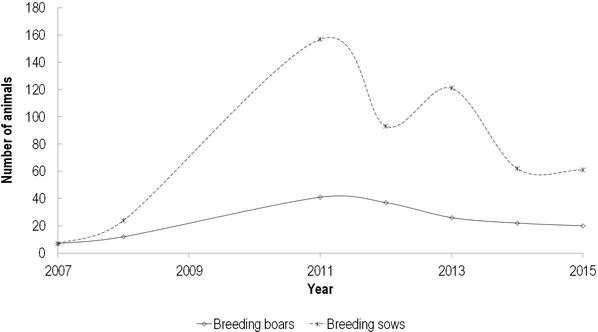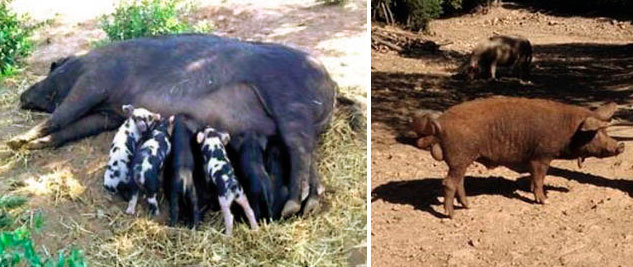History and current status of the breed
The Sarda or Suino Sardo is a breed of domestic pig from the Mediterranean island of Sardinia (Italy). Evidences of the present pig population in Sardinia date back to 2nd millennium BC. Nuragic sites have returned large quantities of bones and some bronze representations of domestic pigs. Historical and bibliographic research and field surveys have shown that pig breeding in Sardinia has ancient origins documented by numerous prehistoric and historical traces. During the Roman domination, due to the tributes that Sardinia was forced to pour and to the presence of large areas of oaks in the island, there was an increase in pig breeding. Medieval period reported various written records on pig breeding. For instance, the “Codice Rurale di Mariano IV” reported the fees for who leave the pigs on the vineyards as well as the rule that forbid to introduce pigs in the pastures during the fall and winter periods. Sarda pigs and wild boars have been sympatric for centuries in the region, and it has recently been showed that Sarda pig breed belongs to Sus scrofa meridionalis subspecies. Since 2006, the breed conservation program based on several small breeding nuclei is active. Presently, there are 13 registered farms of Sarda pigs with about 61 breeding sows and 20 boars in the latest available status. Census of Sarda pig breed is presented in Figure 1.


The Sarda is a small size breed with black, grey, tawny or spotted coat colour (Figures 2 and 3). The bristles are numerous, long and rough, and on the dorsal line, they make up a mane. A lumbar tuft is possible. The head is of medium development, cone-shaped with a straight profile, small ears kept high up or leaning on the side. Wattles are sometimes present. Long tail with bristles sometimes forms a characteristic “horse” tail. Even if the breed presents large phenotypic variability, some morphological traits are considered indicators of crossbreeding and are thus cause of exclusion from the registry: absence of bristles, totally depigmented skin, straight ears, concave profile, striated cloak or agouti, presence of white band, even partial, on the chest. Sows of Sarda breed have on average 12.7 teats.

Geographical location and production system
Sarda pigs are raised mainly in the provinces of Ogliastra and Nuoro but are also present in those of Medio Campidano and Sassari and in the Sarrabus-Gerrei subarea. These are the classical areas of pig breeding in Sardinia as already reported by Cetti. The local pig is bred in the wild or semi-wild without any type of control or fences with frequent exchanges between wild boars and domestic pigs. This is one of the reasons of the difficult eradication of the African swine fever (ASF) disease as reported by Jurado et al. Animals often graze on public lands, with minimal recourse to shelters consisting of hollow trunks or shelters (in wood and/or stone). Animals are fed mainly on the natural resources of the oak and chestnut woods where they graze freely; the integration is minimal and commonly consists of cereals (flour or grain) or legumes, offered during periods of food shortage. With this production system, the animals remain in the herd during more than 1 year and they are slaughtered quite old. It is thus common to simultaneously have young pigs, middle aged pigs, and old animals (up to 3 years of age and more than 100 kg). Furthermore, seasonality of the events (births and slaughters) is a common management practice in Sarda breed. Animals are accustomed by the farmers to respond to their voice calls at pre-established points, where they receive the daily amount of food, directly offered on the ground.
Productive performance
Reproductive traits
According to data registered in the Italian Pig Breeders Association (ANAS) database, the age of sows at first parturition is 25.3 months, whereas the age at culling is 60 months. Sows of Sarda pig breed have 1.2–2.0 litters per year with 5.6–9.4 piglets of only 0.3 kg live body weight. Stillborn percentage of piglets and piglet mortality rate until weaning reported within collected studies are quite high (12.1–16.1 and 11.1–20.0%, respectively. Duration of lactation is prolonged in comparison to modern intensive systems (to 37 days), which leads to a longer farrowing interval (180–304 days) and higher piglet weaning weight (7.7). Extended lactation in such production system serves also as protection against predators as well as to increase the learning process period in such unfavourable areas.
Growth performance
Due to big differences between studies with regard to the live weight range covered, we defined the stages for growth performance as growing stage (from weaning to approximately 30 kg live body weight) and early, middle and late fattening stages estimated between approximately 30 and 60 kg, 60 and 100 kg and above 100 kg live body weight, respectively. In the considered studies, data on the average daily gain in lactation were not found, whereas reported average daily gains in growing, early, middle and late fattening stage were on average 342, 352, 494, and 525 g/day, but it has to be pointed out that the obtained results within each stage were very different and thus the averages reported have to be considered cautiously. The average daily gain in the period from birth to slaughter reported for Sarda pig within the considered studies averages 423 g/day, which is lower compared to modern breeds of pigs. In the context of the evaluation of growth performance, it is also of interest to observe the extreme values, because it can be assumed that the maximum figures exhibit the growth potentials of Sarda pigs in ad libitum conditions of feeding (≈910 g/day in late fattening stage and 657 g/day in overall fattening stage).
In considered studies, the information on feed intake and feed nutritional value were limited, which also limits the evaluation of growth potential. Average daily feed intake increased from approximately 1.1 kg/day in growing stage to 3.6 kg/day in late fattening stage (declared as ad libitum feeding), whereas average daily feed intake in the overall fattening stage was 1.7–2.7 kg/day. In the context of the evaluation of feed intake, it is also of interest to observe the extreme values, because it can be assumed that the maximum figures exhibit the maximal feed intake of Sarda pigs in ad libitum conditions of feeding. Porcu reports that Sarda pigs consumed 6.3 kg/day in late fattening stage when feed was offered on ad libitum basis (estimated between 98 and 294 kg body weight), whereas in overall fattening stage, maximal feed intake reported was 2.7 kg/day (estimated until 100 kg body weight).
Body composition and carcass traits
In considered studies, pigs of Sarda breed were slaughtered at approximately 686 days of age, at an average 193 kg live weight (106–294 kg) and reached dressing yield around 77%. The back fat thickness value measured at the withers varied from 30 to 85 mm, at the position of the last rib 28 mm and at the level of last rib 41 mm. No data providing measurements of muscularity were found in considered studies.

Meat quality
PH values in longissimus muscle at 45 min and 24 h post mortem was 6.07 and 5.98, respectively. Objective colour measured in CIE L, a and b colour space was 48, 14.4, and 8.5 for L, a* and b*, respectively. No data providing measurements of intramuscular fat content and fatty acid composition of intramuscular or back fat were found in considered studies.
Use of breed and main products
More than 50% of Sarda pig farmers raise the animals for the entire cycle producing traditional cured meats used for family needs. The part exceeding self-consumption is sold on the local market, especially during the summer period with a high number of tourists present in the island. The main products are represented by sausages, bacon (rolled up or not), “guanciale” and “coppa” as well as cured ham and shoulder. Equally important is the consumption of piglets, slaughtered at the age of 35–45 days, which is one of the traditional dishes of typical Sardinian cuisine. Besides these classical products, it is possible to recognize three different local productions never recorded in the atlas of typical products: traditional ham, shoulder ham with bacon, and “sartizza a lorika”. This last product is a very long sausage that can even exceed 3 metres in length with a spiral shape and recalls the sausages known as the “longaones” described in the Roman period. Currently, Sarda pig breed and its products face two major problems: the presence of ASF, difficult to control and eradicate due to the type of breeding and the presence of many unrecognized farms (for which it is difficult to establish the real consistency of the animals belonging to the native breed).
Acknowledgments
The research was conducted within the project TREASURE, which has received funding from the European Union’s Horizon 2020 research and innovation programme under grant agreement No 634476. The content of this chapter reflects only the authors’ view, and the European Union Agency is not responsible for any use that may be made of the information it contains.
Riccardo Bozzi, Maurizio Gallo, Claudia Geraci, Luca Fontanesi and Nina Batorek-Lukač (February 6th 2019). Sarda Pig, European Local Pig Breeds - Diversity and Performance. A study of project TREASURE, Marjeta Candek-Potokar and Rosa M. Nieto Linan, IntechOpen, DOI: 10.5772/intechopen.84437. Available from: https://www.intechopen.com/books/european-local-pig-breeds-diversity-and-performance-a-study-of-project-treasure/sarda-pig



